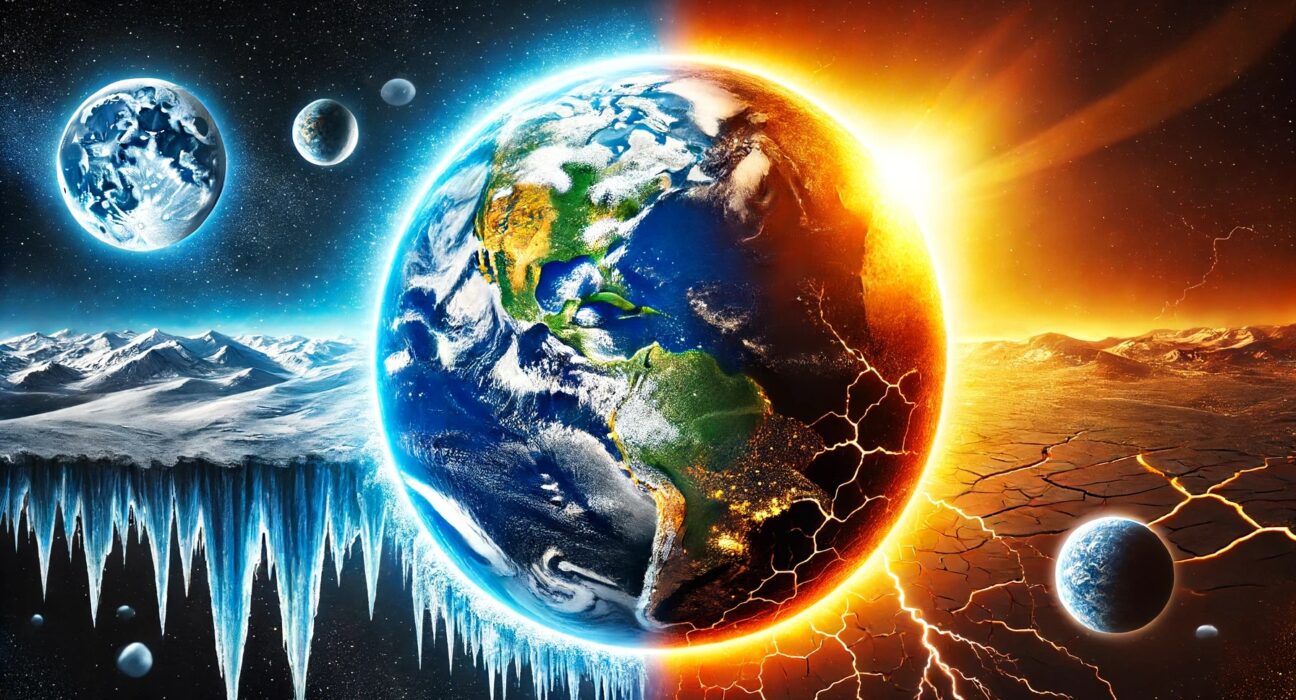Have you ever imagined what would happen if Earth suddenly decided to hit the brakes and stop spinning? Picture a wild sci-fi movie where chaos ensues, temperatures go haywire, and everything we know about our daily lives gets turned upside down. Buckle up for a rollercoaster ride through this fun and slightly terrifying scenario as we explore the dramatic consequences of a standstill Earth.
The Great Standstill: What Would Happen to Our Days and Nights?
Have you ever wondered what would happen if the Earth stopped spinning? Get ready for a fun and slightly scary journey through a world where our planet decides to take a break! Let’s start with the changes in our daily lives.
Immediate Chaos
First, if the Earth suddenly stopped spinning, everything on the surface would continue moving at a speed of up to 1670 km/h. This means that we, buildings, trees, and even the sea would be launched into space like a huge runaway carousel!
Of course, this is just a funny way to think about the immediate disaster, but the reality would be much more chaotic.

The inertia caused by the sudden stop in rotation would fling objects and living beings on the surface sideways. Additionally, the resulting winds from this catastrophic event would be extremely strong, capable of knocking down anything standing.
It would be like a super hurricane hitting the entire planet simultaneously!
Eternal Day and Night
Now, if the Earth gradually stopped spinning, we would have one side of the planet eternally illuminated by the Sun and the other plunged into perpetual darkness.
Imagine one side of the world suffering from constant scorching heat, turning cities into arid deserts, while the other side freezes in an endless night, worthy of the worst icy nightmares. The extreme temperatures would make life almost impossible in many regions.
Disrupted Biological Rhythms
Moreover, our biological rhythms, known as circadian rhythms, would become completely deregulated. These rhythms are responsible for regulating our sleep, hunger, and various other vital bodily processes.
Without the regular alternation of day and night, our bodies wouldn’t know when it’s time to sleep or wake up. It would be complete chaos, with insomnia, fatigue, and many other health problems.
Ocean Redistribution
Another interesting point would be the redistribution of the oceans. Without the Earth’s rotation, the oceans would migrate towards the poles, creating mega-continents in the equatorial regions and immense oceanic basins at the poles.
This would completely alter the geography of the planet, creating new continents and submerging areas we know today.
So, the next time you complain about a rainy day or a cold night, remember that the constant rotation of the Earth is what makes our environment stable and habitable.
Gravity Games: How Your Weight Would Change Overnight
Increased Weight
Did you know that Earth’s rotation plays an essential role in how we feel our own weight?
The centrifugal force generated by Earth’s rotation slightly counteracts gravity, making us weigh a bit less at the equator than at the poles. Without this rotation, the centrifugal force would disappear, and we would all feel heavier, especially in equatorial regions.
This increase in weight might seem insignificant, but it could make physical activities more difficult and impact our health significantly.
Structural Impacts
Additionally, the change in gravity would have profound impacts on the planet’s infrastructure. Buildings, bridges, and other constructions are designed considering the current gravitational force.
Without the centrifugal force to alleviate part of the load, many of these structures might not withstand the additional weight, becoming unstable or even collapsing.

This would pose a significant challenge for engineers and architects, who would need to reevaluate and adapt construction methods to ensure the safety and durability of buildings.
Atmospheric Changes
Another interesting aspect would be the impact on atmospheric circulation.
Earth’s rotation influences wind patterns and global climate, creating systems of high and low pressure that move air around the planet. Without this rotation, global winds would be redistributed, resulting in extreme and unpredictable climate changes.
The absence of rotation could lead to severe weather patterns, with intense and stagnant storms in some regions, while others would face long periods of calm and drought.
This alteration in climate would directly affect agriculture, water availability, and daily life for people worldwide.
Surviving the Standstill: Could Humans Adapt to a Stationary Planet?
Extreme Temperature Changes
Without Earth’s rotation, we would face unimaginable challenges. Firstly, the extreme temperature changes between the side permanently illuminated by the Sun and the side in constant darkness would make vast areas of the planet uninhabitable.
On one side, we would have scorching heat that would evaporate the oceans and create barren deserts. On the other, we would face extreme cold that would freeze everything in sight.
Adapting to these conditions would require advanced temperature control technologies and artificial environments, as well as a massive migration to the twilight zones, where temperatures would be more moderate.
Impact on Agriculture and Resources
In addition to the climatic difficulties, the absence of rotation would drastically affect agriculture and the availability of natural resources.
Crops would have to be adapted to grow in controlled environments, as the natural day-night cycle, essential for many plants, would no longer exist. Water sources would become scarce in areas that were once fertile and abundant.

To survive, humanity would need to develop innovative hydroponic farming systems and desalination technologies to make seawater usable.
Adapting to a stationary planet would not only be a matter of physical survival but would also require a complete reinvention of our society and technologies.
Conclusion
So, if the Earth stopped spinning, we would face a series of complex and unpredictable challenges. However, with creativity and technological advancements, we could transform an apocalyptic scenario into a new way of living.
Ultra-technological cities in the twilight zones, advanced hydroponic farms, and innovative strategies to cope with extreme climate changes would be part of our adaptation.
After all, if humanity can imagine flying cars and colonies on Mars, adapting to a stationary Earth would be just another incredible adventure in our cosmic resume.
Everyday Products for Surviving on a Stationary Planet
Thank goodness the Earth keeps spinning, right? But imagine for a moment if it decided to stop. We would be forced to face one side eternally sunny and the other permanently frozen. Fortunately, this is just a crazy sci-fi hypothesis.
However, the products we’re about to introduce are so useful that they can make your life easier even here on our good old spinning Earth.
Get ready to check out the everyday items that will ensure comfort, safety, and efficiency in any situation!
Portable Fans and Heaters
With extreme temperature variations, portable fans and heaters are essential for maintaining comfort in any environment.
Recommendation:
- Xiaomi Portable Fan – Compact and rechargeable, perfect for cooling off on hot days.
- Lasko Portable Electric Heater – Small, efficient, and easy to transport, ideal for staying warm in cold climates.
Water Purifiers
Ensuring potable water is crucial, especially in areas where water can become scarce or contaminated.
Recommendation:
- Brita Water Purifier – Easy to use and effective in removing impurities, keeping water clean and safe to drink.
Grow Lights for Plants
Growing plants indoors might be necessary, especially without Earth’s rotation. Grow lights help simulate sunlight.
Recommendation:
- Roleadro LED Grow Light – Efficient LED light that provides the necessary spectrum for healthy plant growth.
Portable Power Generators
To ensure a reliable power source, especially in areas with unstable supply.
Recommendation:
- Jackery Explorer 240 Portable Generator – Compact and powerful, ideal for providing power in emergencies and outdoor activities.
Smart Lighting Systems
Adjusting indoor lighting can help maintain an artificial day-night cycle, important for well-being.
Recommendation:
- Philips Hue Smart Bulbs – Smart bulbs that can be controlled via smartphone to adjust lighting as needed.
These everyday products can be extremely useful for adapting to the extreme conditions of a stationary planet, ensuring comfort, safety, and efficiency.
References
- Muir, Hazel. “Tales from an Alternate Earth.” New Scientist, 22 Jan. 2011. doi.org/10.1016/S0262-4079(11)60160-7. Available at: (sciencedirect.com).
- Vitaterna, Martha Hotz, Joseph S. Takahashi, and Fred W. Turek. “Overview of Circadian Rhythms.” Alcohol Research & Health, vol. 25, no. 2, 2001, pp. 85-93. Available at (nih.gov).
- Wahr, J. M. (1988). The Earth’s rotation. Annual Review of Earth and Planetary Sciences, 16(1), 231-249. doi:10.1146/annurev.ea.16.050188.001311. Available at (annualreviews.org).
- Khatiwada, P. (2020). Determination of Center of Mass and Radius of Gyration of Irregular Buildings and its Application in Torsional Analysis. International Journal of Engineering and Technology, 7(10), 1-7. Available at (researchgate.net).








